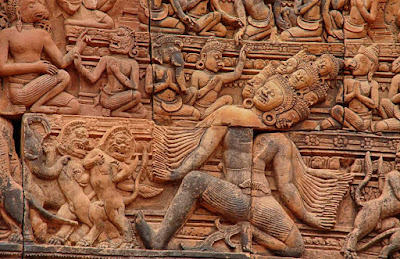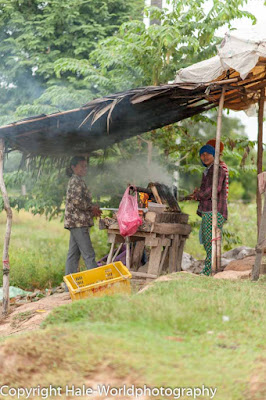 |
| Trench cut into Nong Hon Kumphawapi |
In
this region of Thailand there are several stories about two mythological characters: Nang Ai and Pha Daeng. The
plots vary but they all agree in that Nang Ai was a very beautiful woman
and Pha Daeng was a handsome stranger from far away, the ruler of
a land called Phaphong.
In one story of Nang Ai and Pha Daeng, Nang Ai's
beauty and fame catches the attention of Phangki, son of the Naga King,
Phaya Nak. Phangki shape shifts himself into a very handsome man to
court Nang Ai. Phangki is not successful in his efforts to win over Nang
Ai from Pha Daeng. Frustrated he once again shape shifts but this time into a white
squirrel to better track and keep an eye on Nang Ai with the intent of
finding an opportunity to kidnap her.
When Nang Ai and
Pha Daeng see the white squirrel, they order a royal hunter to trap it.
The squirrel, son of the King of the Nagas, ends up dying. The meat is
fed to the people of the town. It miraculously keeps increasing until
8,000 cartloads of meat is fed to the people of the city and surrounding
villages. (Hmmm - reminds me of another story that I know but it is
with fish instead of squirrel meat.). Phaya Nak, King of the Nagas,
vows to kill everyone who has eaten his son's flesh.
After eating, a very large
thunderstorm suddenly hit the city. Since that did not typically
happen, Pha Daeng tried to escape quickly with Nang Ai on his horse, Bak
Sam, from the rising flood. All of Isaan is turned into a swamp. The
escape was not successful. Nang Ai is swept off the horse by the tail of
a naga. The spirit of the white squirrel had become King of the Nagas
and had taken Nang Ai into his underwater kingdom.
Pha
Daeng is devastated by the loss of his true love, Nang Ai, and soon
dies. His spirit recruits and organizes an army of spirits from the air
to wage a long war against the Naga Kingdom. The war eventually ends
in a stalemate, both sides too tired to continue.
It is
said that the Nong Hon Kumphawapi Lake is a remnant from the flood and
the trench that can be seen today in Tambon Pho Chai was created by Bak
Sam's erection as he ran to escape the flood.
Ban Thasang (Thasang Village) is located on the edge of the floodplain of the Lam Pao River that crosses Nong Hon Kumphawapi (Kumphawapi Swamp) flows into Nong Hon Kumphawapi Lake.
Duang's sister's farm is bordered by a trench cut into Nong Hon Kumphawapi, however this trench was not gouged out of the floodplain by Bak Sam's erect penis. The wide trench is actually man-made, ecavated a few years ago my backhoes and excavators. The trench was made to store water later into the dry season and to concentrate fish for fishing at the end of the monsoon season.
 |
| Isaan Fisherman |
Last Sunday, just after I stopped photographing the village furniture maker, a pickup truck carrying 6 men crossed my sister-in-law's property and parked alongside the trench bordering the farm. I followed their truck along the top of the dike along the trench to where they parked.
The men got out, undressed, and put on their fishing clothes - old clothing that could be immersed in muddy water for hours. Once dressed for fishing, the men gathered up their fishing gear; a roll of netting about one meter tall and roughly 10 meters long, fine mesh throwing fish nets weighed along their perimeters, floating creels - hand woven reed or bamboo baskets with recycled soda bottles or scraps of Styrofoam attached to their sides to enable them to float, and a plastic wash tub.
 |
| Fish net hoists and platforms along the trench |
The men did not speak English but understood that I was going to take photographs of them - much to their amusement. I followed along, behind them along the top of the earthen berm past several bamboo fishing net hoists and platforms built along the berm. In several locations, weirs constructed of nylon netting and sticks driven by hand into the muddy bottom reached from the shoreline into the receding waters of the ditch.
We walked along the main trench until we came to first branch trench and walked a very short distance along it. At the "proper location", the men walked down the berm and entered the shallow opaque still muddy water of the trench. The proper location had easy access to the water but more importantly it was near an existing fishing net installed across the ditch marking the end of someone else's fishing zone.
The fisherman worked together to place their unrolled fish net across the ditch. When they needed longer or more sticks to fasten their net, they climbed the far side bank of the ditch and cut brush to meet their needs.
With a section of the ditch cordoned off between the existing net and their newly placed net, the men proceed to fish the area with five men throwing their hand nets at one end of the containment area working their way down to the other en where one man threw his hand net. Their technique was to cover the ditch in a systematic process driving any escaping fish down towards the man at the other end in an ever decreasing area for the fish.
 |
| Casting net upon the waters |
Prior to starting their fishing operations, the men offered me to join them. I told them that I was afraid and pantomimed the motion of an inchworm (leech) crawling on me and attaching itself to my leg. The men understood and as they were laughing, one of the men told me that leeches were "ping". I then told the men that I was afraid that ping would eat me. They all had a hardy laugh and one of them told me not to be afraid that there were no leeches. Yeah right ... and "the check is in the mail" and we have all heard that similar saying "I won't ___ in your mouth " I asked the man "Really, no leeches?" We all enjoyed another hardy laugh ... together as they all went into the water as I remained on the berm - high and dry.

The men threw their hand nets so as to cover the water from shore to shore in an overlapping pattern created by several throws. There was no bait or any inducements to attract the fish. It was all based upon luck and trying to ensure that any fish had no where to swim off to. The net was thrown and allowed to sink to the bottom - about one meter below the surface. Once the net had settled to the bottom, the fisherman retrieved it by pulling on a small diameter rope attached to it.
When the net was retrieved, he inspected it to see what if anything he had caught. These were not sports-fisherman. They were not going after game fish or any record catches. They were fishing for food for themselves and their families that evening.
In over 7 years here, the largest fish that I have seen caught either with these hand nets or the large rectangular nets suspended from bamboo hoists, was no more than 1/2 pound (225 grams). The overwhelming majority of the fish caught would not even have been used for bait fishing back in the USA. The fish are small, often tiny, minnows. However, they are protein and no doubt a welcomed flavor to compliment a meal of rice. The fish are also free.
When a fish was captured the fisherman would remove it from the net and place it in the creel floating next to him in order to keep it alive and fresh. More often then not, there were no fish. More frequently than not, the net would dredge up snails, sometimes two or even three. When that occured the fisherman would gather them up and place them in the plastic tub placed on the shore at water's edge. The snails are about the size of a small tangerine and are a stable in the Isaan diet. However they are also dangerous.
Liver cancer is the No. 7 cause of death in Thailand. There are 23,000 new cases of liver cancer a year in Thailand. Udon Thani is the the epicenter of liver cancer in Thailand.
Liver cancer in this area is due to a parasitic infection, Opisthorchiasis - liver flukes. Due to cultural dietary practice and preference people are part of the liver fluke's life cycle. Here people are accustomed to and like to eat two dishes that involve raw fish - "koi pla" - finely chopped raw fish mixed with chilies, herbs, lime juice and live red ants: "pla ra" - the ubiquitous Lao condiment - fermented (six months or longer) raw fish sauce - Lao people's answer to our ketchup.
People can become infected with liver flukes by consuming the larvae attached to raw fish flesh. Inside of the human liver the larvae mature, become flukes, and reproduce creating eggs. People pass the eggs into the waterways through rural sanitation practices. Back into the waterways, the eggs are eaten by the snails which are then eaten by fish where the larvae develop and the cycle begins once again. Tradition has been to use raw fish for koi pla and to use raw fish to make the fish sauce. Cooking and pasteurizing destroys the larvae and prevents the development of cancer over the years of consuming koi pla and pla ra. There are education programs in schools and hospitals to educate people to not eat raw fish but as they say ... old habits are hard to break. Duang's father and her ex-husband both died of liver cancer - no doubt as a result of their eating raw fish.

After observing and photographing the fishermen for about an hour, I thanked the men and said goodbye to return to our home 65 Km to the north. To be honest, I looked but did not see any leeches on them but I did not do a full body scan or close up inspection. I still believe that there are leeches in those murky still waters. I will still not enter any water that looks like this. But I will gladly return to take more photos of others in those waters.



















































